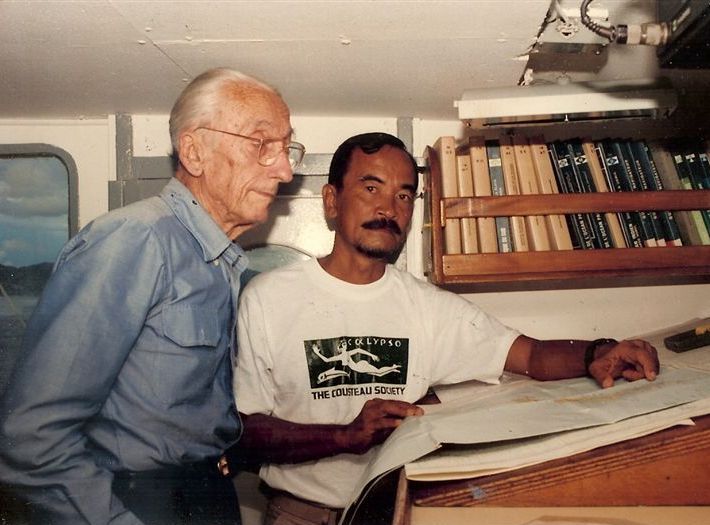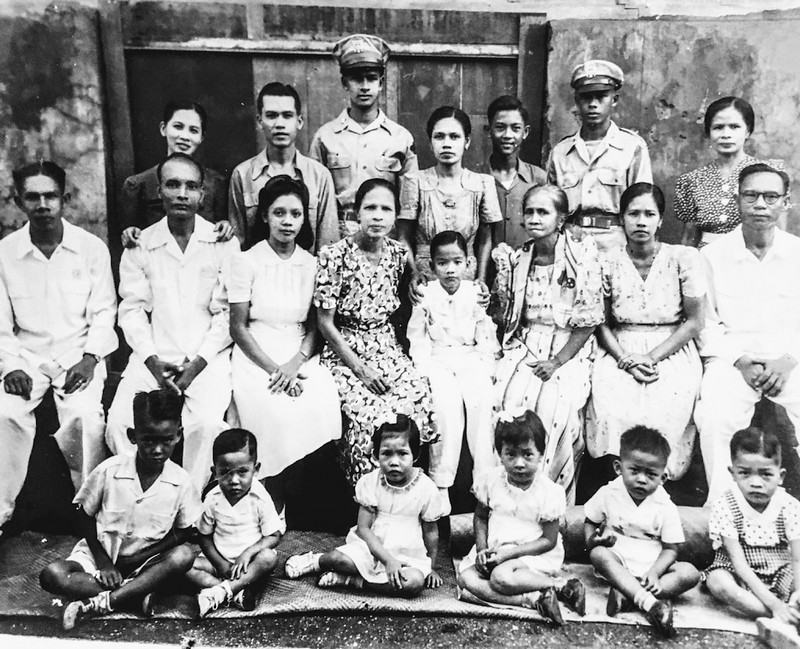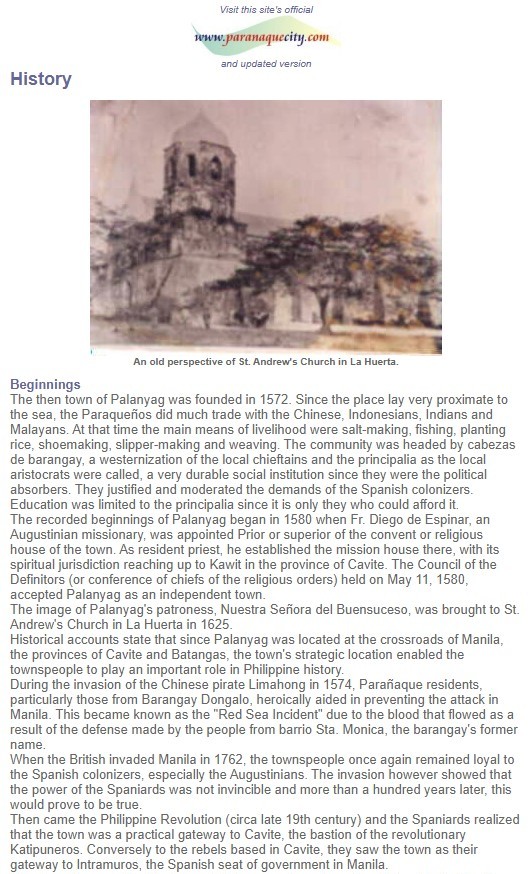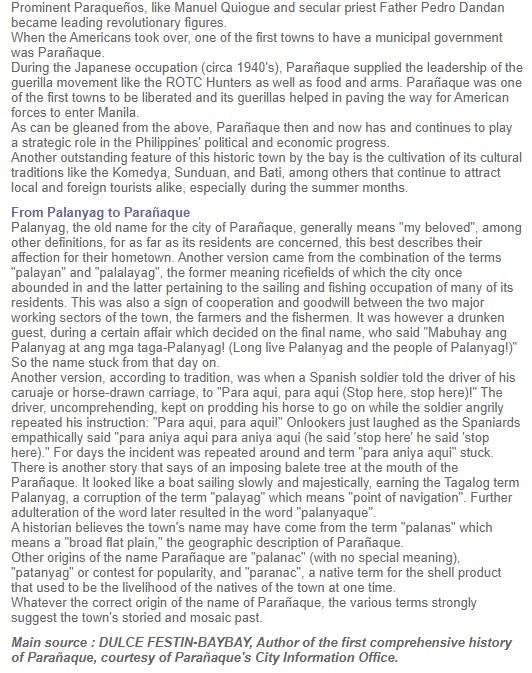

A PASSAGE OF AN ARTIST
THRU TIME AND SPACE
by Popoy Castañeda

Popoy, the diver and guide, and the legendary Jacques-Yves Costeau study Palawan's hydrographic chart.
[See: A Betan's Journey Thru Time and Space, in Memoirs & Reminiscences]
Part 1 - My Life in
La Huerta
I am Porfirio Castañeda, firstborn of Dominador Castañeda and Sofia Gregorio. We
came to live here in La Huerta, Palanyag because my father who was a painter and
taught art at the University of the Philippines, which was then at the Padre
Faura campus, loved the beautiful settings and sceneries of the old Palanyag
(now Parañaque City) rather than as a concession to my mother who belonged to
the De Leon-Tomas clan of the town. We lived in a big Spanish style house that
occupied a sizable portion of the corner of Calle M.H. del Pilar and San
Nicolas. At the house were the following:
o Dominador my father; my mom Sofia; and my brother Lito, who was a toddler
then
o Lola Tina Augustina de Leon, youngest sister of Valentino de Leon
o Lola Juana Tiongkiao vda de Leon, widow of Valentino de Leon
o Auntie Auring Leonore, daughter of Velentino and Juana de Leon
o Kuya Nil Nilcar Hallare
o Tio Tabing Octavio
o Tio Jose
o Tio Rasing Horacio
o Two maids and any relatives and friends staying for the night

CASTAÑEDA FAMILY PHOTO - June 24, 1945
Front row: Ed Pascual,
Augusto Gregorio, Aurora Gregorio, Carmelita Pascual, Cielito Pascual and
Joselito Castañeda (my brother).
Middle row: Tio Jose de leon,
Dominador Castañeda (my father), Auntie Juanita
Palaganas-Gregorio, Augustina de Leon (Lola Tina),
Popoy Castañeda (me),
Lola Juana Tiongkiao-de Leon, Auntie Elisa de Leon-Pascual and Cornelio Santos.
Back row: Sofia
Gregorio-Castañeda (my mother), Dr. Augusto Gregorio, Uncle Major
Octavio de Leon,
Leonore de Leon, Kuyang Nilcar Hallare, Lt. Horacio de Leon and Auntie Josefina de Leon-Santos.
It was in this house that I became aware and conscious of my sorroundings ("nagkamalay tao"). I was born on September 15, 1937 so the anecdotes I will be writing about would have taken place around 1940. As introduction to my anecdotes, allow me to picture or describe to you the house. The house was on the corner of M.H. del Pilar and San Nicolas streets. The house faced M.H. del Pilar but the entrance was at the San Nicolas side. The house was composed of two big bedrooms; one spacious sala; a room called “silid” where bed linens, sleeping mats ("banigs"), mosquito nets, pillows, clean and dirty laundry were kept and a safe room for any of the boys to sleep in when they broke Lola Tina’s curfew. The main bedroom with two big beds were occupied by Auntie Auring, Lola Juana, Kuyang Nil, myself, and Tio Jose who bedded in front of the entrance. In the other bedroom was Lola Tina; my mother, father and baby Lito; Tio Tabing; and Tio Racing. Any visitors for the night slept on mats at the spacious and cool sala. The maids slept in the "comedor", the dining room. Adjacent to the comedor was a "batalan", a wet washing area floored and walled with bamboo slats where laundry was done and also where the icebox was placed. It also functioned as a spare bathroom for the men to take a quick shower with a pail of water. Adjacent to the comedor was a wide area paved with terracotta tiles (now called Vigan tiles). This was the kitchen area. On one corner was a 3-woodburner stove with the stack of firewood. There was also a cooked food locker called "pamingalan" with a lock whose key was kept by Lola Tina. Refrigerators were unheard of then.
At that time there were only 2 cars in La Huerta: one
was owned by Judge Jose Bernabe and the other one was a taxi driven by Francisco
“Ka Kiko” Nery. There was also a big kitchen work table. The azotea was also the
access to the bathroom which was a narrow way with galvanized iron room with a
single low watt light and a jar of rainwater for the women to shampoo their hair
using "gogo" vine. All the women at the house had long hair. The longest was
that of Lola Juana which was past her waist. On the open space leading to the
backstair was a wide area with 4-5 Vigan jars of rain water for the bathroom. So
when you were taking a bath you would ask the maids; or you would get a big
pail, take it in the bathroom and do your thing. At the other end of the
kithchen was a tower-like structure of stone accessible through a 4-step
concrete stairs. This was the toilet, entirely made of stone, except for the 3
commodes, which was a single plank of Molawin wood about 18 inches wide and 4
feet long with 3 holes. In the center was the largest, the right hole was very
small and the left one midway. So, left to right, you have small, large and
medium. I was never allowed there. Then I was to use an "arinola" then ask the
maid to dispose of it. Later when I was maybe five years old I was allowed the
use of that toilet as long as I went with Kuya Nil, Tio Racing or Tio Tabing.
The toilet was a direct system meaning your thing accumulated below and just let
nature take over.
There was no water system in Parañaque. That would come 9 years later. There was
also a yard at the back of the house adjacent to the property of Filemon
Leonardo, a barber, tailor and musician. Between the toilet tower and the
backstairs was the well, 2 ½ meters wide, walled with tiles. Water from that
well was used only for cleaning the house, not for kitchen use. The water from
the well was used for laundry washing and to clean the window sill, benches and
the stairs whose steps were 12 inches wide. The dining kitchen tables, Lola
Tina’s bedroom floor, the comedor and the toilet seat were cleaned using water
and the sand paper leaves of the Isis tree. Planted in almost all the backyard
of homes in Parañaque that time, our Isis tree grew on the other side of the
backstairs. The entrance of the house was at the San Nicolas street side (the
entrance was exactly where the door to the present home of Lou Gonzales was
located). You entered the gate marked by a big acacia tree with big leafed
Philodendron and bouganvillas climbing over its crown. You would enter and walk
on the footpath. The foyer was directly underneath Lola Tina's bedroom. On your
left was the stairs with 12 inches wide steps of Molawin planks scrubbed with
sandpaper leaves every Saturday to a gleaming white. You left your footgear for
everyone went up the house barefooted. Especially on the sala, it was the only
floor in the housed waxed and polished daily with coconut husks by alternate
schedules of Tio Tabing, Tio Jose, Tio Racing, my father and the maids.
At the house activities ran on a semblance of schedule. We woke up to the church
bells at 5:30AM. However almost everybody was up and around. Lola Tina and Lola
Juana were already having their coffee. Tio Tabing would already be sweeping
with a broom the front (M.H. del Pilar) and the side (San Nicolas) portion of
the streets. This was done by almost all the households in La Huerta. Tio Jose
and Tio Racing were already clearing up the beddings, mosquito nets, sleeping
mats, pillows and sheets. At the kitchen rice was boiling and frying. Auntie
Auring or Nanay Sofy would already be at the market to get whatever fresh caught
sea food was available. The general favorite seafood for breakfast was “pinangat
na sapsap" (boiled slipmouth), paksiw na banak, sinigang na silinyasi. Special
treats would be hipon kulot, alamang and fresh blue crabs. Other breakfast
specials would be tapang kabayo (horsemeat jerkey) eaten with fresh boiled rice
dunked with fresh carabao’s milk. Breakfast was served on the dining table.
People with very early commitments were served earlier on the kitchen table. My
father, who taught painting at the University of the Philippines, was always up by
then and ready to go. The lunch "baons" for those needing them were ready on the
kitchen table after breakfast. Lola Tina or Lola Juana accompanied by either
Nanay or the maids would go to the market to get lunch and dinner. Then
refrigerators were not yet in general use. (We got our refrigerator when I was
in Grade 3 in 1947).
People bought what can be consumed in a day. Also Parañaque at that time meat
was only available at the market on Saturdays and Sundays. So except fot the
occasional tapa beef or horsemeat or the isolated chicken, it was purely a
seafood and vegetables 6 days a week. Weekdays lunch and dinner would be fish
and seafoods We had a variety of dish. For example for each kind of fish we had
different recipe of sinigang. For bangus it would be be sinigang sa mangga, sa
sampaloc or bayabas. Herring or "silinyasi" was sinigang with kamias. On Sundays
we had meat for lunch, and dinner the dishes were few. First on the list was
nilagang baka (now popularly known as bulalo). Next would be sinigang na karneng
baka or sinigang na baboy. Then we had Lauya which was the poor man’s version of
the pochero. The mentioned dishes were standard in La Huerta on Sundays. Lunch
broken every now and then when my uncles brought lechon or oysters.
Now going back to my story, by 8 o'clock everybody had gone to do their
business: Auntie Auring to her teaching at Malate; Tio Jose to his dental
clinic; Tio Tabing ang Tio Racing to their work in Manila; and the marketing
detail, either my Nanay, Lola Juana or Lola Tina with one of the maids.
Sometimes Tio Jose went with Lola Juana since his clinic was in one of the
schools in Las Piñas. By this time time I was allowed to play down at the the
backyard garden (this part of the property corresponded to the garage and
kitchen of Lou Gonzales and the rear end rental house of Vangie Gregorio).
The backyard garden was cared for by Lola Juana and Tio Jose. The garden
included the big acacia tree with a meter diameter trunk festooned with plate
sized variegated Philodendron and its trunk and its branches covered with
bouganvillas whose summer flowers shrouded the entire crown with a scarlet veil.
The secret to this I soon found out was when I saw the maids dumping the chamber
pots at the base of the acacia and Lola Juana collecting horse manure from Lolo
Camilio's one horse stable (Lola Tina’s older brother who was a cochero) and
applying it to the base of the variegated San Francisco plants which lined the
footpath to the main entrance of the house. The roses in the garden, the big
treelike gardenia bush (Rosal) at the corner of the garden and even the Isis
tree. In addition this Isis tree was regularly fertilized with fish entrails.
At the yard I was either under the surveillance of my mom, one of the maids,
Lola Juana, Tio Jose or Ka Hermie, the washer woman who came twice a week and
washed our clothes downstairs near the well (she didn't want to do it at the
"batalan" because hauling water upstairs from the well was backbreaking). Ka
Hermie Sebastian lived behind the San Nicolas chapel and this was one reason why
I was allowed to frequent the the back of the San Nicolas chapel which was the
bank of the Parañaque river. Every now and then during Saturdays or late in the
afternoon Tio Tabing wouild take me to the empty lot belonging to Lola Tina
obliquely in front of the San Nicolas chapel squeezed in by the house of Osmundo
Santiago on the east and Nana Tina’s on the west. Tio Tabing had in his garden
plots of bok choy, lettuce, radishes, jicamas and peanuts. Tio Tabing had also
planted with Kuya Nil, and me tagging along, an Isis tree and sweet guavas in
the lot. (This was to be the lot where my father and mother would build a house
after World War II and would be passed to me until the present).
Tio Tabing also took me and Kuya Nil trapping crabs. Tio had 25 of those traps
“bintol” but only when they set the traps at the bank of the river behind the
San Nicolas chapel would I always be the one sitting by the big basket were the
live crabs catch were kept. Those times my Tatay was always with us sketching
and doing his watercolors. This end of San Nicolas street was very wide and
served as a basketball court for the La Huerta Falcons basketball team. Some
team members I remember were Tio Tabing, Ka Nomer Felipe (Pacing Gregorio’s
father), Peping de Castro, Rudy Bond, Ninong Augusto, Ka Pedro San Pedro. They
practiced every Saturday morning.
Life with us at La Huerta flowed flaccidly and then rumors and news of eminent
war between the USA (the Philippines then was a commonwealth under the USA) and
Japan. We started practicing blackouts, raid alerts, and built designated air
raid shelters. Then there came a time when there was curfew and blackout every
night. Volunteers were recruited from the community to patrol the streets when
blackout and curfew were enforced. Then one cold early December morning the US
Naval base at Sangley Point and Nichols Air base were simultaneously bombed. At
this time and period of my story there is no chronological order. All I remember
was the dawn bombing of the Nichols airbase, now the Manila International
Airport. We all ran downstairs and took shelter at the foyer under Lola Tina's
room because her room had thick Molawin planks for flooring. What I can remember
next was that we were all in a borrowed truck driven by Tio Tabing and we
evacuated to Lola Juana’s farm at Barrio Talon, Las Piñas. So one cold morning
a few days after the war erupted we were loaded in a big truck with all our
belongings including sleeping mats, mosquito nets and chamber pots.
(To be continued)
Links:
o Part 1 - My Life in La Huerta
******************************************************
Web note: an excerpt on the history of Parañaque


Back ---> Memoirs & Reminiscenses)